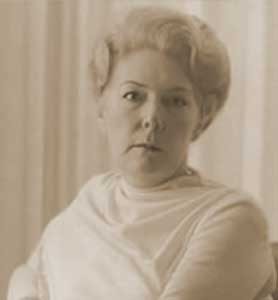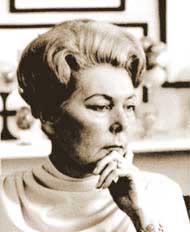
Courtesy of Ahmed Essa
The information below has been compiled from a variety of sources. If the reader has access to information that can be documented and that will correct or add to this woman’s biographical information, please contact the Nevada Women’s History Project.
At A Glance:
Born: January 7, 1923 in Los Angeles, California
Died: November 13, 1983 in Reno, Nevada
Maiden Name: Joanne (Joan)
Cutten de Longchamps (variant spelling DeLongchamps)
Race/Nationality/Ethnic Background: Caucasian
Married: Galen Edward de Longchamps, January 21, 1941 in Pasadena , California.
Children: Dare de Longchamps
Primary City and County of Residence and Work:
Reno (Washoe)
Major Fields of Work: Poet, Artist
Other Role Identities: Wife, Teacher
Joanne de Longchamps was Nevada ‘s foremost poet of the 1960s and 1970’s. She wrote seven books of poetry, two of which were illustrated with her own art work, and more than 300 uncollected poems.
Joan Cutten, her name before she married Galen de Longchamps, was reared in Los Angeles by her mother who ran a dance studio. Her parents had divorced when she was a child, therefore, her mother, Ruth Avery Cutten, who had danced with Isadora Duncan, was the dominant parent in her life. Joan was comfortable in the Hollywood atmosphere, and was surrounded by the stars who worked at the studio. It is not surprising that Joan had aspirations to be a starlet.
She demonstrated her talents early, writing her first poem when she was just five years old.
Joan accompanied her mother on travels to Europe , and while in France she studied art and music. Joan attended high school in both France and Los Angeles . By age sixteen she was offered but turned down, a Warner Brothers contract. Her picture did appear on magazine covers as a result of some modeling she was doing. It was one of these pictures that the young Galen de Longchamps saw in the Los Angeles home of a friend of his mother. He made the comment that he would certainly like to meet that girl. He was able to meet her and they were married on January 21, 1941 in Pasadena , California , when Joan was eighteen. Galen de Longchamps was a mining engineer and the couple made their home in Reno .
When she married Galen de Longchamps, she married into an established Reno family. He was the adopted son of Frederic de Longchamps, the popular and well known Nevada architect. Also, she changed her first name to Joanne when she was married.
Both she and Galen enrolled at the University of Nevada in Reno . Galen completed his studies, but Joan never did. She immersed herself in the university life by auditing every class the art department offered for twenty years, taking ceramics, collage, painting and more. She also became a lecturer at the university, and taught classes for the next decade. She studied with author Walter Van Tilburg Clark and artist Robert Caples, among others.
She began publishing poems in regional and national magazines and literary journals. Her first book of poems, “The Hungry Lions”, was published when she was just 40, in 1963. Her paintings and collages were exhibited at local and regional shows.
De Longchamps probably would have won greater renown had she lived in a more populous area. Yet she recognized the advantages of remaining close to the source of her inspiration, her beloved desert. She loved the Great Basin , its air, its vast spaces its glorious light. “If I had wanted to be great”, she said, “I supposed I’d have gone to New York or I’d have gone back to Hollywood and picked up my contacts. What I want is the feeling of being surrounded by people who sense and try to create this marvel of being alive. I don’t believe in all this, the rewards of position and power. No, I don’t think Nevada is a cop-out at all.”
Patty Atcheson Melton, a graphic artist and portrait painter, lived next door to Joanne and Galen on Center Street just outside the university gates. Mrs. Melton tells of lamenting to Joanne that no one in the university art department was encouraging her in her desire to become a portrait painter. Joanne’s comment was, “Well, do portraits. They didn’t like my collages, but I do them.” People who admire the collages feel Joanne painted with a knife rather than a brush. University of Nevada art professor Walt McNamara has said of the collages, “She refined the art of collage. There is a surrealistic fantasy quality to her work which has reached a very sophisticated level.”
During the summer of 1971 she made a trip through parts of Africa and Greece . She maintained a meticulous notebook of plant life, descriptions of people, food, and places. She noted colors and textures. Out of this trip came a series of poems and collages reflecting her observations, especially a number of works dealing with lions. Many people think these are some of her finest works.

University of Nevada Reno Library
One of her books of poetry is named The Schoolhouse Poems . This book is named for the schoolhouse that Joanne and Galen bought from the Washoe County School District . In a letter dated December 9, 1974 , Joanne wrote “Three years ago Galen and I acquired (at an auction from the School District ) an acre of land at timberline. It lies under the dominion of Mount Rose and Galena Creek. In one corner of this acre is the schoolhouse – a one room building of hand-cut local stone. To my knowledge, this is the third schoolhouse to stand on or near this site. The first was built when the town of Galena thrived in the 1860’s, a timbering town (no longer in existence) that supplied the mines of Virginia City . The schoolhouse which was such a special place became a source of anguish for the de Longchamps. Their son, Dare, who had graduated from Pepperdine College committed suicide by carbon monoxide poisoning at the schoolhouse. Joanne was never able to visit here again.
Joanne de Longchamps was a prominent member of the Reno arts community. She exhibited at several galleries and published poems in university publications, in local magazines and papers, and in books published both before and after her death. She was a regular contributor to the West Coast Poetry Review. Her name was added to the Nevada Writers Hall of Fame in 1989. In 1991 her impact was still being felt through her poems chosen for inclusion in the poetry anthology entitled Desert Wood edited by Shaun Griffin.
Joanne also performed as an accomplished pianist. In 1973 she collaborated on a musical score dedicated to the Reno City Council with the intent that the song would become a Reno theme song. The refrain is “ Reno , Fantastic Reno – A river city that is filled with light. It whirls with color in Nevada ‘s night.” The song was first performed at the Pioneer Theater with the Reno Philharmonic on October 28, 1973 . It did not become the theme song as envisioned, but it exemplified the involvement of Joanne de Longchamps with Reno and Nevada .
Joanne struggled with cancer and multiple sclerosis in the last 10 years of her life. She died of cancer on November 15, 1983 . She had been divorced from Galen since June. Ironically, in that same year, she had been honored by the university where she spent so many years but from which she had not graduated. She received an Honorary Doctor of Letters at graduation on May 21 of 1983. President Joe Crowley left the stage went down the steps and awarded the honor to de Longchamps who was in a wheelchair. Sadly, she died in isolation. She was quoted as saying “ Nevada hardly knows me as a poet.”
Also, in 1983, a retrospective of her work was held from October 21 until November 15. She willed her home to the university to be used as a guest house for visiting professors and dignitaries. Retired UNR professor Jim McCormick said of her passing, “We’ve lost a person who has committed her entire life to a vital kind of personal expression, both in poetry and visual arts.”
Original biographical sketch by Pat Kloss, Revised by Nancy Oakley in 2005
Awards:
- Reynolds Lyric Award from Poetry Society of America in 1954 and the Carolina Quarterly Annual Award from the University of North Carolina in 1959. She was appointed the first Walter Van Tilburg Clark Chair in Creative Writing at UNR in 1973 and received the Nevada Governor’s Art Award for Literature in 1983. In 1989 she was inducted into the Nevada Writer’s Hall of Fame.
Published Works:
- Griffin, Shaun T., ed., Torn by Light, Reno: University of Nevada Press, 1993. Selected poems by Joanne de Longchamps.
Sources:
- Internet: Glass, Betsy , Nevada Writers Hall of Fame , Biography www.library.unr.edu , June 17, 2003
- Kloss, Pat, Biography of Joanne de Longchamps, 1991
- Reno Gazette Journal, “Writers Hall of Fame honors Wheeler, de Longchamps”, October 12, 1989, p. 2E
- Kay, Fahey, “Torn by Light,” Silver and Blue , vol. V, no. 1, p 20-22, September/October, 1993
